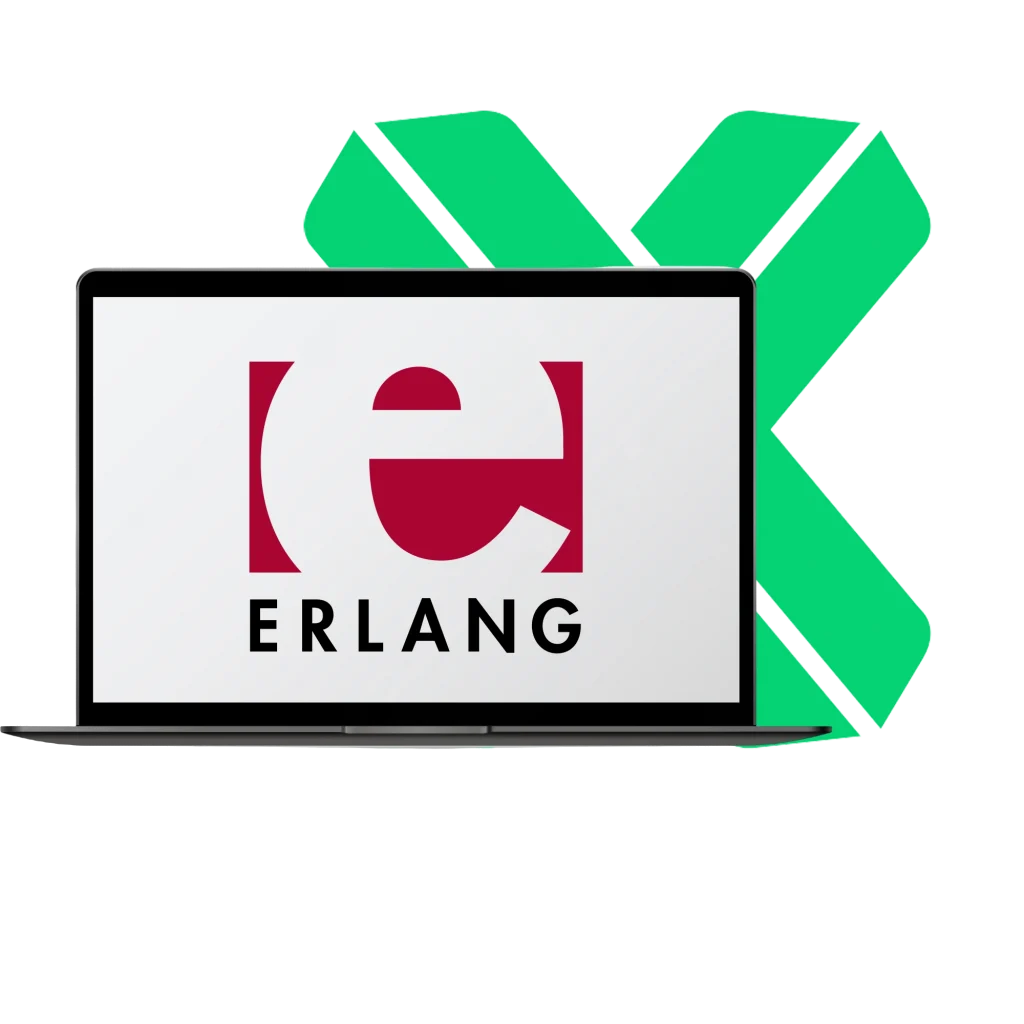ERLANG DEVELOPMENT COMPANY
Build highly reliable, concurrent systems with Erlang and nearshore talent.
We quickly assemble skilled teams to build distributed systems using Erlang’s proven concurrency model, ensuring reliability and seamless performance for complex, mission-critical applications.

+200 companies rely on
our 1% Top Talent

Erlang Development Services We Provide
We offer a wide range of Erlang development services, from building distributed systems to real-time communication platforms. Explore our key offerings below:
Custom Erlang Application Development
We build custom applications using Erlang, leveraging its unique strengths in concurrency and fault tolerance. From messaging systems to large-scale distributed applications, we develop solutions that guarantee uptime, performance, and scalability.
Real-Time Systems Development
Our team uses Erlang to create real-time communication systems, including messaging platforms, telecommunication services, and live monitoring tools. Erlang’s ability to handle millions of concurrent connections ensures low-latency, high-availability systems.
Distributed Systems and Microservices
We design and develop distributed systems and microservices using Erlang’s powerful concurrency model. Whether you need scalable, reliable microservices or a complex distributed architecture, Erlang ensures smooth communication and fault tolerance across services.
Telecommunications and Networking Solutions
Erlang is widely used in the telecommunications industry for building highly reliable networking solutions. We develop telecommunication systems, VoIP services, and network management platforms that require high availability and real-time data processing.
Fault-Tolerant Systems with OTP
We build fault-tolerant systems using Erlang’s OTP (Open Telecom Platform), ensuring your applications recover from crashes with minimal downtime. OTP’s built-in support for fault tolerance and supervision trees ensures robust, resilient applications.
Erlang Maintenance and Optimization
We provide ongoing maintenance and performance optimization for your Erlang applications, ensuring they remain scalable, secure, and up-to-date. Our team monitors performance, handles updates, and resolves issues to ensure smooth operation.
Why Choose Xpertsoft for Erlang Development
Nearshore Expertise
Our developers are primarily based in Portugal, ensuring seamless collaboration with EU-based clients. With real-time communication and bilingual professionals, we offer efficient Erlang development and support services.
Broad Technical Expertise
Beyond Erlang, our team brings expertise in real-time systems, distributed architectures, microservices, and fault-tolerant solutions. We deliver end-to-end services that ensure your Erlang applications are scalable, secure, and optimized for performance.
Tailored Erlang Solutions
We provide flexible Erlang development services that align with your business needs. Whether you need distributed systems, real-time applications, or telecommunications solutions, we tailor our services to meet your scalability and reliability requirements.
The Erlang Ecosystem We Used in Previous Work
Distributed Systems and Real-Time Applications
Leverage Erlang’s concurrency and fault tolerance for building reliable systems:
- OTP (Open Telecom Platform) (for building fault-tolerant, distributed systems)
- Mnesia (for distributed database management in Erlang)
- Cowboy (for high-performance HTTP servers)
- RabbitMQ (for messaging queues in distributed applications)
Telecommunications and Networking
Build scalable, reliable telecommunication and networking platforms using these tools:
- Ejabberd (for building real-time messaging systems)
- Yaws (for building scalable web servers in Erlang)
- Netconf (for managing network configurations)
- Telecom-specific protocols (for custom telecommunications solutions)
Security and Performance Optimization
Ensure secure, high-performance Erlang applications with these tools:
- Erlang SSL (for securing communication between nodes and services)
- PropEr (for property-based testing and ensuring code reliability)
- Prometheus (for monitoring and visualizing performance metrics)
- Grafana (for real-time performance dashboards)
Key Facts to Know About Erlang Development
- Benefits of using Erlang
-
1. Built for Concurrency and Fault Tolerance
Erlang was designed from the ground up to handle massive concurrency and fault tolerance. Its lightweight process model allows millions of processes to run concurrently, making it ideal for real-time communication systems and distributed applications that require high uptime.
2. High Availability and Fault Recovery
Erlang’s OTP (Open Telecom Platform) provides built-in mechanisms for fault recovery and high availability. This makes Erlang systems highly reliable, ensuring minimal downtime even in the face of failures, making it perfect for mission-critical applications.
3. Scalability for Distributed Systems
Erlang’s distributed nature and ability to handle multiple nodes seamlessly make it a go-to choice for building scalable distributed systems. It’s widely adopted in industries like telecommunications, finance, and messaging systems, where scalability is paramount.
- Erlang is primarily used for
-
Erlang is primarily used for building distributed, fault-tolerant systems that require high concurrency and low latency. It’s widely adopted in telecommunications, messaging platforms, real-time systems, and high-availability applications.
- Reasons for Erlang's popularity
-
- Proven Track Record in Telecommunications: Erlang was originally designed for building telecommunication systems, and it has been battle-tested in environments where uptime, reliability, and scalability are critical.
- Concurrency Without Compromise: Erlang’s actor model allows developers to create highly concurrent applications without the typical issues found in multi-threaded systems, like deadlocks and race conditions.
- Fault Tolerance and Self-Healing Systems: Erlang’s supervision trees and OTP framework allow applications to automatically recover from failures, making it perfect for systems that need high fault tolerance and zero downtime.
- Distributed Systems with Minimal Complexity: Erlang’s ability to handle multiple nodes and run distributed applications seamlessly makes it a powerful choice for developing large-scale systems that span across geographies and data centers.
- Ideal for Real-Time Applications: Erlang excels at real-time applications that require low latency and high concurrency, making it the preferred choice for messaging platforms, live updates, and telecommunications.
- Strong Community and Ecosystem: Erlang’s long history and active developer community ensure access to a wealth of resources, libraries, and tools that streamline development and enhance functionality.
- Low Resource Usage: Erlang’s lightweight processes use minimal memory, allowing it to handle millions of processes simultaneously, making it highly efficient for real-time, distributed applications.
- Useful Links
-
1. Built for Concurrency and Fault Tolerance
Erlang was designed from the ground up to handle massive concurrency and fault tolerance. Its lightweight process model allows millions of processes to run concurrently, making it ideal for real-time communication systems and distributed applications that require high uptime.
2. High Availability and Fault Recovery
Erlang’s OTP (Open Telecom Platform) provides built-in mechanisms for fault recovery and high availability. This makes Erlang systems highly reliable, ensuring minimal downtime even in the face of failures, making it perfect for mission-critical applications.
3. Scalability for Distributed Systems
Erlang’s distributed nature and ability to handle multiple nodes seamlessly make it a go-to choice for building scalable distributed systems. It’s widely adopted in industries like telecommunications, finance, and messaging systems, where scalability is paramount.
Erlang is primarily used for building distributed, fault-tolerant systems that require high concurrency and low latency. It’s widely adopted in telecommunications, messaging platforms, real-time systems, and high-availability applications.
- Proven Track Record in Telecommunications: Erlang was originally designed for building telecommunication systems, and it has been battle-tested in environments where uptime, reliability, and scalability are critical.
- Concurrency Without Compromise: Erlang’s actor model allows developers to create highly concurrent applications without the typical issues found in multi-threaded systems, like deadlocks and race conditions.
- Fault Tolerance and Self-Healing Systems: Erlang’s supervision trees and OTP framework allow applications to automatically recover from failures, making it perfect for systems that need high fault tolerance and zero downtime.
- Distributed Systems with Minimal Complexity: Erlang’s ability to handle multiple nodes and run distributed applications seamlessly makes it a powerful choice for developing large-scale systems that span across geographies and data centers.
- Ideal for Real-Time Applications: Erlang excels at real-time applications that require low latency and high concurrency, making it the preferred choice for messaging platforms, live updates, and telecommunications.
- Strong Community and Ecosystem: Erlang’s long history and active developer community ensure access to a wealth of resources, libraries, and tools that streamline development and enhance functionality.
- Low Resource Usage: Erlang’s lightweight processes use minimal memory, allowing it to handle millions of processes simultaneously, making it highly efficient for real-time, distributed applications.
Add top 1% devs to
your in-house teams
Tap into the expertise of our top 1% developers. Staff augmentation lets you boost your in-house teams with specialized experts. Expedite timelines without sacrificing output quality.
Here’s how we augment your team

STEP 1
Discovery Call
Share your requirements, budget, and necessary skill sets. We will draft a working timeline and select top developers for your team.
STEP 2
Assembling Your Team
Withindays, we’ll find suitable developers that fit your requirements. We ensure they have the right technical expertise and would be a great cultural fit for your team.
STEP 3
Onboarding and Scaling
After onboarding them, our developers will integrate with your team. Scale your engagement as needed – we’re happy to accommodate your demands.
Get an
entire Team
Looking to bring on more than just a few .NET developers? We’ll assemble a complete crew to support you. Whether it’s full-cycle front and back-end web development, QA, DevOps, UX/UI, or something else. Monitor the team’s performance and manage them as you see fit.
Here’s how you can get a dedicated team

STEP 1
Discovery Call
We’ll learn about your business, organization structure, objectives, budget, timelines, and resource requirements. Then, we can start identifying the ideal talent for you.
STEP 2
Team Assembly and Integration
Once we assemble your dedicated team, we’ll ensure a smooth transition as they integrate with your organization.
STEP 3
Project Kickoff
After onboarding, your team is at your disposal. You’ve now acquired the resources you need without the hassle and high cost that usually comes with recruitment
